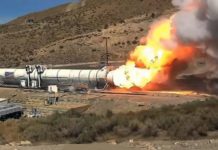
Sept. 23 (UPI) — Experience, charisma — and previous exposure to radiation in space — will guide NASA’s history-making decision to choose the first woman who walks on the moon, according to those familiar with space agency operations.
NASA Administrator Jim Bridenstine has said the woman selected will be experienced and will have flown on space missions. Ten current astronauts meet that criteria, and more could soon.
In addition to expertise, NASA will look at the ability to perform well on high-profile missions and to connect with the public, space exploration observers said.
And, some of the most experienced astronauts could be ruled out if they have too much radiation exposure, according to space medicine experts.
Among the potential moon mission candidates, astronauts Christina Koch, 41, and Jessica Meir, 43, raised their profiles earlier this year by carrying out the first-ever all-female spacewalk while stationed on the International Space Station. Koch also set a record for living in space longer than any other woman at 328 days.
Koch and Meir’s stature most likely improved after completing their tandem spacewalk, said Nancy Vermeulen, an astrophysicist, pilot and founder of the Belgium-based Space Training Academy.
High pressure
They demonstrated that the two women could work together in a high-pressure situation under the media spotlight, Vermeulen said.
“NASA monitors the synergy among astronauts on a team, how people cooperate together,” she said.
But those achievements will pale when compared to walking on the moon, said retired astronaut Kathryn Sullivan, the first American woman to walk in space in 1984.
NASA is keenly aware that a moon mission “will catapult this woman, whoever she is [and] make her an icon and role model in a different way than most astronauts,” Sullivan said.
Despite creating that fame, NASA’s first priority will be “to make sure this mission will succeed and the crew has the right capabilities and chemistry,” she said.
Of NASA’s 48 active astronauts, 16 are women. Bridenstine and Vice President Mike Pence have committed to sending one of them on the first moon landing in 2024. Four astronauts will make the journey, and two will land, including the woman.
At a 2019 event, Bridenstine went further, saying the 2024 mission could have more than one woman.
As for the actual selection, NASA first will identify an as-yet unknown number of Artemis astronauts to train others and help establish requirements for flights to and around the moon, Bridenstine said in August.
Elite group
“This elite group will include some of the men and women who will fly on early Artemis missions, and we will add more to the team in the future,” Bridenstine said via email.
In terms of experience, and among those who could lead the way, three female astronauts have flown on more than one mission.
Sunita Williams, 54, spent 322 days in space over the course of two missions. She is scheduled for her third mission in early 2021 aboard Boeing’s Starliner space capsule, should it pass its final uncrewed flight test planned for December.
In 2006, Williams served as a flight engineer on a space shuttle mission to the International Space Station. In 2012, she was launched aboard a Russian Soyuz capsule to the space station.
Williams carried out seven spacewalks, and she and retired astronaut Peggy Whitson broke records for most spacewalks by a woman. Whitson currently holds the mark with 10.
Tracy Caldwell Dyson, 51, flew on a space shuttle mission in August 2007, which added equipment and structural parts to the International Space Station. In 2010, she was launched aboard a Russian Soyuz capsule and spent 174 days living and working aboard the space station as a flight engineer.
Stephanie Wilson, 53, has flown three space shuttle missions — all of which were about two weeks long — in 2006, 2007 and 2010. All three missions delivered equipment and supplies to the space station. Wilson operated the station’s robotic arm and served as flight engineer, assisting the commander and pilot.
Oldest person ever
If NASA choses one of these women for a lunar landing, she would be the oldest person ever to walk on the moon.
Apollo moonwalkers’ ages ranged from the youngest, Charlie Duke at 36, to Alan Shepherd at 47. Spaceflight experts said age no longer is the barrier it once was, but physical fitness and agility will be important to endure the mission and move about in cumbersome spacesuits.
In the next year, at least three more women are scheduled to fly on their second space mission — Megan McArthur, 49, Kathleen Rubins, 41, and Shannon Walker, 55.
And three astronauts have been to space once — Koch, Meir and Anne McClain, 41.
Two women astronauts, Jeannette Epps, 49, and Nicole Mann, 43, are scheduled for their first trip into space within the next 12 months.
Five women have yet to go into space and have no scheduled missions — Zena Cardman and Kayla Barron, both 32; Jasmin Moghbeli, 37; Loral O’Hara, 37, and Jessica Watkins, 32.
High-profile mission
NASA chooses astronauts carefully for all missions, and especially so for historical milestones, retired astronaut Sullivan said.
That includes Neil Armstrong, Buzz Aldrin and Michael Collins on Apollo 11 and John Young and Robert Crippen on the first space shuttle launch. Sending the first American woman, Sally Ride, into space also was a high-profile decision.
Armstrong was chosen for Apollo 11 because he was a test pilot and an engineer. NASA officials selected him over crewmate Buzz Aldrin to step on the moon first because they thought he didn’t have as big an ego, according to a 2001 book by the late Chris Kraft, NASA’s first flight director.
NASA picked Young as the first space shuttle mission commander in 1981 because he was a seasoned space veteran with four missions and a walk on the moon.
Sullivan said that neither she nor Ride knew why they were chosen for their historic missions.
The role that astronauts assume on such missions as a standard-bearer for NASA and the nation weighs heavily on the choice. But subtle psychological issues come into play, as well, Sullivan said.
Need to be photogenic
“I wouldn’t be shocked if the choice of a woman for the moon mission is sort of slanted toward someone photogenic,” Sullivan said. “It’s virtually never in play with men, but it’s been a subconscious factor at NASA for women.
“There are archetypes that resonate more with society, and I think that’s going to be a factor.”
She wrote about NASA’s view of women in her book, “Handprints on Hubble,” which also describes the triumphs and frustrations of her career and how she came to deploy the storied telescope in orbit.
While the space agency may value charisma, technical requirements for the first such deep-space mission in decades will be paramount, said Brian C. Odom, the acting NASA chief historian.
“NASA will take everything they’ve learned over the decades and apply those lessons to this decision” on crew members, Odom said.
“Historically, crew selection depends on the mission and what astronauts are expected to do, so the first mission of its kind often has had pilots and engineers prove the spacecraft capability,” Odom said.
Connect with public
Even so, NASA may favor astronauts who have shown an ability to connect with the public such a historic mission, he said.
“Historically, the expectation is that they would be very adept at speaking to the public,” Odom said. “NASA aims to inspire people to get involved and follow in the footsteps of astronauts.”
While experience is crucial, a limiting factor could be radiation to which astronauts have been exposed.
“I doubt age will matter as much as previous radiation exposure, which NASA does consider when choosing astronauts for long-term missions,” said Virginia Wotring, a scientist with the International Space University in France. Her career has focused on health impacts of extended duration space flights.
NASA will disqualify astronauts for having an elevated cancer risk, based on measurements kept by their personal radiation counters, or dosimeters. At the International Space Station, astronauts receive about 10 times the amount of radiation they do on Earth.
Because deep-space missions have a higher risk of radiation exposure, the most likely candidates are those with one successful mission, Wotring said. They would be Koch, Meir, McClain and possibly Mann and Epps after they return from space.
Most radiation
At the same time, Koch’s record duration in space for a woman means she also has been exposed to more radiation than the other women. But because older astronauts are thought to have less time to develop cancer, they may not be disqualified based on more radiation absorbed, Wotring said.
Mission requirements also may mandate that someone with geology expertise be on the first Artemis landing. That’s because NASA confirmed this week it will investigate water ice on the first landing. Astronaut Watkins is a geologist.
The timing remains uncertain for naming the crew to make this first return to the moon flight. NASA doesn’t have a timeline for specific flight assignment announcements, the space agency has said.
But NASA will approach that announcement with caution, said Amy Foster, associate professor at the University of Central Florida, who specializes in space history.
While women are a minority among the 48-member astronaut corps, the space agency also could make a statement by selecting a women who represents another minority, Foster said.
Three of the eligible women astronauts are African American — Epps, Watkins and Wilson. Moghbeli is Iranian-American, while McClain is the only known gay or lesbian astronaut.
However, it’s quite likely NASA will pick a woman astronaut who otherwise is not a minority, Foster said. “Right now, I think checking the one box, in terms of historical minorities [among astronauts], is as risky as NASA will be,” she said.
New generation
In making its decision, NASA also will seek to appeal to a new generation of Americans who weren’t born when man first walked on the moon.
Sending the first woman there will be almost as important as repeating a landing for the first time since 1972, said astronaut Serena Aunon-Chancellor, who has retired from spaceflight, but still helps to train other astronauts.
“My hope is that young women from all over the world will watch these tremendous events unfold and, without hesitation, begin to forge their own path in space exploration,” Aunon-Chancellor said in a statement to UPI.
The first woman moonwalker will be an icon for girls, women and society for many years to come, the International Space University’s Wotring said.
“I find myself in a strange position when I’m talking to young people who tell me that as a woman scientist, I am inspirational to them, and I’m just working in a lab here on campus,” she said.
“So I think it’s going to be incredibly powerful to see a woman walking on the moon — and change the equation forever.”





